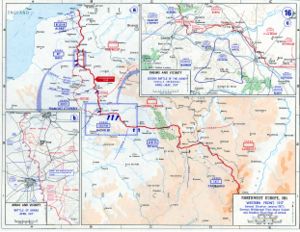Nivelle offensives
| Nivelle Offensive | |||||||
|---|---|---|---|---|---|---|---|
| Part of the Western Front of World War I | |||||||
 The Western Front, 1917 |
|||||||
|
|||||||
| Belligerents | |||||||
|
|
|
||||||
| Commanders and leaders | |||||||
|
|
|
||||||
| Strength | |||||||
| 850,000 troops 7,000 guns, 128 tanks |
c. 480,000 | ||||||
| Casualties and losses | |||||||
|
French: 118,000–187,000 British: 160,000 Russian: 5,183 |
c. 163,000 (15,000–20,780 prisoners) |
||||||
The Nivelle Offensive of 1917, was a Franco-British offensive on the Western Front in the First World War. The French part of the offensive was intended to be strategically decisive, by breaking through the German defences on the Aisne front within 48 hours, with casualties expected to be around 10,000 men. A preliminary attack was to be made by the French Third Army at St. Quentin and the British First, Third and Fifth armies at Arras, to capture high ground and divert German reserves from the French fronts on the Aisne and in Champagne. The main offensive was to be delivered by the French on the Chemin des Dames ridge (the Second Battle of the Aisne, La bataille du Chemin des Dames, Seconde bataille de l'Aisne and Doppelschlacht Aisne-Champagne), with a subsidiary attack by the Fourth Army (the Third Battle of Champagne, the Battle of the Hills or Battle of the Hills of Champagne). The final stage of the offensive was to follow the meeting of the British and French armies, having broken through the German lines, with a pursuit of the defeated German armies towards the German frontier.
The Franco-British attacks were tactically successful; the French Third Army of the Groupe d'armées du Nord captured the German defences west of the Hindenburg Line (Siegfriedstellung) near St. Quentin from 1–4 April, before further attacks were repulsed. The British Third and First armies achieved the deepest advance since trench warfare began, along the Scarpe river in the Battle of Arras, which inflicted many losses on the Germans, attracted reserves and captured Vimy Ridge to the north. The main French offensive on the Aisne began on 16 April and also achieved considerable tactical success but the attempt to force a strategically decisive battle on the Germans failed and by 25 April the main offensive had been suspended.
...
Wikipedia
